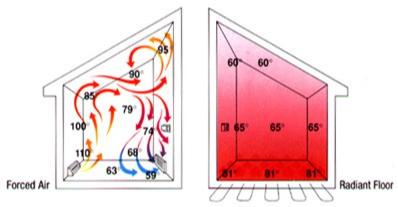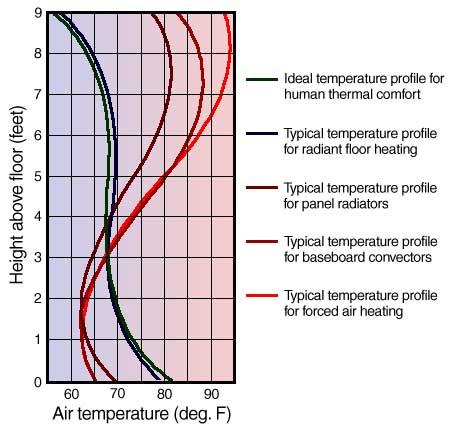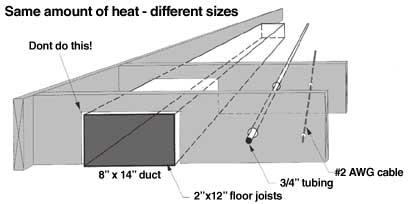A detailed look at Radiant Heating and Why people want it.
Advantages of Radiant Panel Heating
A properly designed and installed radiant panel heating system offers many advantages.
Some are simply the elimination of a "side effect" created by another method of heating. In other cases, they're unique conditions that only radiant panel heating can provide. Here's a listing of the major benefits along with a brief explanation of each.
1. Radiant panel heating improves comfort by increasing a room's average surface temperature.
Remember
that a large portion of our body's heat loss is by radiation to cooler
surfaces surrounding us. The cooler these surfaces are, the faster they
"pull" heat from us and the more uncomfortable we feel. By warming the
interior surfaces of floors, walls, ceilings, windows and doors,
radiant panel heating reduces radiant heat loss from our bodies.
Because we're especially sensitive to our radiant surroundings, this
significantly improves comfort.
Figure 1 " Heat Distribution with forced air is uneven. Most of the
heat is concentrated at the ceiling. With radiant floor, the heat is
concentrated at the floor where it is needed. So, you are comfortable
at a lower thermal setting ... that saves money on your monthly fuel
bills.
2. Radiant panel heating allows comfort at lower air temperatures.
Because radiant heat loss from the body is reduced, a greater portion of the body's heat output shifts to convection. This in turn necessitates a greater temperature difference between our exterior surfaces and the air around us. Most people engaged in light activity will be very comfortable in radiantly heated rooms with air temperatures in the mid 60F range. If the activity level is greater, light shop work for example, comfort is often maintained with air temperatures in the low 60F range.
3. Radiant floor heating provides an almost ideal match to human thermal comfort requirements.
The "ideal" temperature variation from foot to head level is shown in Figure 2 along with the "typical" temperature profile created by other heat delivery systems. Note that the temperature profile created by the heated floor is an almost perfect match to the ideal scenario.

Figure 2 " Floor to Ceiling Temperature Profiles of Various Systems
4. Radiant floor heating reduces or in some cases eliminates room temperature stratification.
The familiar (but uncomfortable) situation of warm air blanketing the ceiling while cool air pools at floor level is eliminated. Not only does this improve comfort, it reduces heat transfer through the ceiling and upper portions of the wall. It also reduces "stack-effect" air leakage from the building. The greater the height of the interior space, the more beneficial this characteristic is. The need for "paddle fans" to push warm air back down to the occupied zone of the room is eliminated in most cases.
5. Many radiant panel heating systems are totally out of sight.
Whether constructed with hydronic tubing or electric cable, heated floors, walls, and ceilings conceal their function as heat emitters. There are usually less constraints imposed on furniture placement. The architectural aesthetics of rooms can be preserved without compromising thermal comfort.
6. Radiant heating systems are easily zoned.
Many radiant panel heating systems, both hydronic and electric, are designed for room-by-room zoning. Not only does this offer the potential for energy savings by reducing temperature in unoccupied rooms, it also allows different occupants to adjust rooms to their own desired comfort level. In addition, room-by-room zoning helps prevent localized overheating due to solar or other types of internal heat gain.
7. Radiant heating systems create gentle room air circulation.
In most cases the air motion is so slow that it's not detectable by occupants. Central forced-air systems, by contrast, often create very noticeable whole-building air circulation. The latter tends to distribute dust, odors, and airborne viruses throughout the entire building. Some central forced-air systems also pressurize rooms as they operate, increasing air leakage and wasting energy.
8. Hydronic and electric distribution systems supplying radiant panels are easily and unobtrusively routed through buildings.
The small tubing or electrical cables supplying radiant floor heating panels are easily concealed within (or routed through) the structural cavities of most buildings. By contrast, air ducts of equivalent heat carrying ability often require careful planning and structural alterations if they're to be totally concealed. (Figure 2)

Figure 2 " Heat Transport Capacity of Duct, Tube, and Electric Cable
Each of the illustrated systems could convey approximately the same
amount of heat under typical operating conditions. The tubing and cable
are easily routed through the framing. The hypothetical cut shown in
the floor joist to accommodate the duct would actually destroy its
structural integrity.
9. Radiant floor heat systems with high thermal mass (such as heated concrete slabs) can respond quickly to increased loads when necessary.
Many heat delivery systems such as forced air and hydronic baseboard have low thermal mass. This limits the rate of heat output to the heating capacity of their heat source. By contrast, a heated floor slab with its large reservoir of heat can release a "burst" of heat when necessary. An example is when a large overhead door in a garage is opened and cold air floods in across the floor. Comfort conditions are reestablished very quickly after the door is closed.
10. Radiant floor heating systems with low thermal mass (such as electric ceiling panels) release heat almost instantly when turned on.
This characteristic allows an almost instantaneous improvement in the thermal comfort of a cool room. Although the objects and air in the room will require some time to warm, radiant floor heat loss from the body is reduced within a couple of minutes of turning on the low mass panel.
11. Heated floors dry quickly.
Not only does this improve safety, it also provides much better working conditions for those who routinely work on or near wet floors. It's a tremendous benefit in facilities such as auto service garages, fire stations, or other vehicle service facilities.
12. Many types of radiant panels are very resistant to physical damage.
Tubing or wiring encased in concrete floors is very resistant to damage from heavy interior traffic. Likewise, heated ceilings are typically "above the fray" and thus less likely to be damaged by normal building usage.
13. Radiant floor heating panels can operate with virtually no noise.
Properly designed and installed systems eliminate expansion noise, sheet metal vibration, or velocity noises caused by fast moving air. However, attention to detail during installation is crucial in achieving a quiet distribution system.
14. Low temperature hydronic radiant panels are adaptable to almost any type of heat source and fuel.
Low-temperature heat from solar collectors, geothermal heat pumps, or waste heat recovery systems can often be utilized. Such heat is only marginally suitable for other types of delivery systems.
15. Radiant panel heating reduces energy consumption.
There are several reasons that support this statement:
- Since comfort is maintained at lower air temperatures the heating load associated with air exchange is reduced. The greater the heating load due to air exchange, whether by natural leakage or forced ventilation, the greater the energy savings.
- Easy room-by-room zoning control allows unoccupied spaces to be reduced in temperature, thus reducing total heating load.
- Reduced rates of air leakage by eliminating the "stack effect" inside buildings.
- Reduced conductive heat loss through ceilings by eliminating the layer of warm air normally present against its lower surface.
- Low water temperatures in some types of hydronic radiant panel systems improve boiler efficiency and reduce heat loss from distribution
- High thermal mass systems have the potential to make good use of low cost "off-peak" electrical utility rates where available.
- The electrical energy consumption of small circulators used in hydronic radiant panel systems is usually lower than blowers in forced-air systems of similar heating capacity.
Estimates of how much energy a radiant panel heating system saves relative to other methods of heating can vary considerably. It's not uncommon to hear savings claims of 20 to 30% or more. Many factors influence the extent of energy savings attained by a given system. For example, how well will a given project "exploit" the energy saving characteristics noted above. Buildings with high ceilings, relatively poor insulation, high air exchange rates, or a combination of these characteristics definitely have the potential for greater savings using a radiant panel heating system. Certainly the quality of design and installation of the radiant panel system as well as the system it's being compared to will affect the results.
Heating professionals are urged to use caution in stating energy savings to prospective clients. In time, each company installing radiant panel systems has the opportunity to build a portfolio of projects, some of which have a "before and after" record of fuel usage. Such documented projects provide a credible way of demonstrating the energy savings of radiant panel heating. It's also important to keep in mind that although reduced energy usage is likely, and certainly desirable, it's seldom the top priority of today's consumer.